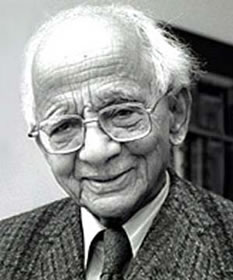De Turkse schrijver Sait Faik Abasıyanık werd geboren op 23 november 1906 in Adapazarı. Zie ook alle tags voor Sait Faik Abasıyanık op dit blog en ook mijn blog van 23 november 2010.
Uit: Hisht, Hisht!… (Vertaald door Ufuk Özdağ)
„I WAS WALKING. The more I walked, the better I started to feel about things. I’d left home with so much anger piled up inside me. Maybe it was the razor blade that made me so angry. Oh yes, certainly. The razor blade! For sure, that’s what got me so mad.
The green of the grass, the blue of the sea, cloudless clear skies . . . Well these, mind you, are things to ponder, certainly. Who on Earth would deny this? Foolishness! What if it rained . . . what if the green grass was purple . . . what if the blue sea was red . . . If that were the case, that would be a thing to worry about, indeed.
I saw a leaf the color of chocolate, a goat the color of green almond. Someone, from behind, called out:
Hisht!
I turned around to check. The still not-so-tall fresh thistles at the edge of the road and the French lavender stared at me with a plum-tasting look. My teeth squeaked. There was no one on the road, not a single soul. I saw the roof of a house, one or two birds flying in the distance, the sea through the leaves. As I continued walking, I heard:
Hisht, hisht!
I wanted to turn around and look. Maybe because I wanted to so much I could not. Well, that could be it. Maybe a bird flew overhead, sounding hisht hisht. Maybe a snake, a tortoise, or a hedgehog passed from behind me. Perhaps there is a certain beetle, sounding like hisht hisht.“
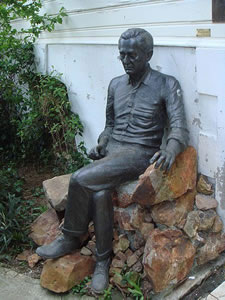
Standbeeld op het eiland Burgazada
De Amerikaanse dichter, schrijver, vertaler, schilder en illustrator Guy Mattison Davenport werd geboren op 23 november 1927 in Anderson, South Carolina. Zie ook alle tags voor Guy Davenport op dit blog en ook mijn blog van 23 november 2010.
Uit: An Introduction to Archilochos
„Of the Greek poets of the seventh century BC we know almost nothing and none of their poems has come down to us entire. Archilochos was a professional soldier from the Aegean island of Paros; Sappho a member of a distinguished family on Lesbos, an island off the coast of Asia Minor; and Alkman was a slave and choirmaster in the Lydian city Sardis before he emigrated, or was sold to, Sparta, where he wrote the two hymns, to Artemis and Hera, which assure him a place all his own in literature.
Archilochos is the second poet of the West. Before him the archpoet Homer had written the two poems of Europe; never again would one imagination find the power to move two epics to completion and perfection. The clear minds of these archaic, island-dwelling Greeks survive in a few details only, fragment by fragment, a temple, a statue of Apollo with a poem engraved down the thighs, generous vases with designs abstract and geometric.
They decorated their houses and ships like Florentines and Japanese; they wrote poems like Englishmen of the court of Henry, Elizabeth and James. They dressed like Samurai; all was bronze, terra cota, painted marble, dyed wool, and banquets. Of the Arcadian Greece of Winckelmann and Walter Pater they were as ignorant as we of the ebony cities of Yoruba and Benin. The scholar poets of the Renaissance, Ambrogio Poliziano and Christopher Marlowe, whose vision of antiquity we have inherited, would have rejected as indecorous this seventh-century world half oriental, half Viking. Archilochos was both poet and mercenary. As a poet he was both satirist and lyricist. Iambic verse is his invention. He wrote the first beast fable known to us. He wrote marching songs, love lyrics of frail tenderness, elegies. But most of all he was what Meleager calls him, “a thistle with graceful leaves.” There is a tradition that wasps hover around his grave. To the ancients, both Greek and Roman, he was The Satirist.“
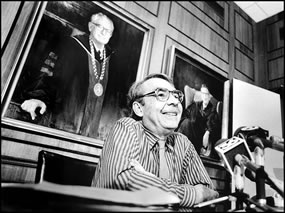
Guy Davenport (23 november 1927 – 4 januari 2005)
De Schotse schrijver en historicus Nigel Tranter werd geboren op 23 november 1909 in Glasgow. Zie ook alle tags voor Nigel Tranter op dit blog en ook mijn blog van 23 november 2010.
Uit: The Queen’s Scotland
„The first and second floors are vaulted, and the latter has a handsome pillared fireplace and a delightful little vaulted oratory, only seven feet square, with holy-water stoup, aumbry and pointed-arched window. Also a tiny laird’s bedchamber above at half-floor level, with a private stair, and a squint-hole to look down unseen into the hall. The building is in the care of the Department of the Environment, and open to the public. The Auchinlecks or Afflecks of that Ilk were hereditary armour-bearers to the Earls of Crawford, and one did homage to Edward of England in 1306. The family provided a number of provosts for Dundee. The modern mansion stands near by, where the key is obtained. The last of the name to hold the lands disposed of them to one Robert Reid in the mid-17th century. Reid of Affleck was forfeited for his share in the Rising of 1745.
The village of Craigton is small, a scattered place but pleasant, lying at the other, east, end of the reservoirs. On the wooded Downie Hill to the south, within the large Panmure estate, are two features. One, highly obvious, is the tall chimney-like tower 105 feet high, rising out of curious small rustic chambers at ground level. This is known as the “Live and Let Live Monument”, and was erected by the tenantry of Lord Panmure in 1839, in enduring testimony to the kindness and generosity of the laird, William Ramsay Maule, created 1st Lord Panmure after the forfeiture of his ancestor, the 4th Earl of Panmure, for his Jacobite activities. Seven counties can be seen from the parapet of the monument, which is a conspicuous landmark from the sea.“
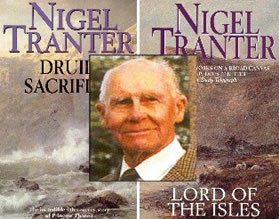
De Duitse schrijfster Marieluise Fleißer werd geboren op 23 november 1901 in Ingolstadt. Zie ook alle tags voor Marieluise Fleißer op dit blog en ook mijn blog van 23 november 2010.
Uit: Hiltrud Häntzschel: Marieluise Fleißer. Eine Biographie
„In Elaine Feinsteins Roman Loving Brecht (London 1993) tritt zwar keine Fleißer-Figur auf, aber im Kern erzählt er die Fleißer-Brecht-Episode, so wie sie durch die Rezeption von Fleißers Erzählung Avantgarde zur Legende geworden ist. Fleißers Übersetzerin ins Englische, TinchMinter, diente dieser Stoff als Vorlage zu einem Theaterstück: Growing herself some Armour. Johann Kresniks und Uschi Ottens choreographisches Theater Brecht (1998) schwelgt im Leiden der Geliebten und Mitarbeiterinnen durch den sexbesessenen Frauenhasser Brecht; Marieluise Fleißer spielt darin eine zentrale Rolle, und ihre Sprache hat den Ton vorgegeben. Die Theaterstücke Atzenköfls Töchter von Kerstin Hensel und Marieluise von Kerstin Specht (an den Münchner Kammerspielen aufgeführt unter dem Titel Die Rückseite der Rechnungen) waren Ingolstädter Auftragsarbeiten zum 100. Geburtstag der Dichterin 2001, beider Thema ist mehr oder weniger die Lebenserzählung Marieluise Fleißers. Sie ist eine Literatin, die zu Literatur geworden ist. In einer Zeit, da uns Dichter-Heroen und ihre Biographien suspekt sind und absichtsvoll unterlaufen werden, ein ungewöhnlicher Fall.
Jene 1971 von Kroetz geforderte Gesamtausgabe erschien bereits ein Jahr später und stellte einen gewaltigen Kraftakt dar. In einer konzertierten Aktion von Autorin, Herausgeber und Verleger entstand eine dreibändige, ausführlich kommentierte Ausgabe. Kaum ein Text blieb unbearbeitet, sozusagen in letzter Minute wurden neue Fassungen erstellt, neue Titel gefunden; zahlreiche Texte wurden aus dem Gesamtoeuvre ausgeschieden, Anmerkungen unterstützen und steuern die Lektüre, ein Essay des Herausgebers über Leben und Schreiben der Marieluise Fleißer aus Ingolstadt im ersten Band führt in die Lektüre ein und weist dieser die Richtung: “Da bei der Fleißer alles von Biographie ausgeht, da Biographie sich direkt in Literatur umsetzt, schlägt auch die Literatur bei ihr wieder in Biographie zurück.”
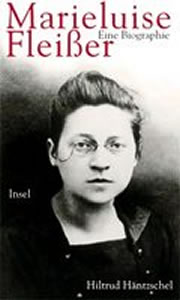
Omslag biografie
De Bengaals-Indische schrijver Nirad C. Chaudhuri werd geboren op 23 november 1897 in Kishoreganj. Zie ook alle tags voor Nirad C. Chaudhuri op dit blog.
Uit:The Autobiography of an Unknown Indian
„My father and mother were bound to each other by certain common principles and standard of conduct, but otherwise, in appearance, temperament, and outlook, they were the reverse or, if one chooses to say the same thing in a different way, the complement of each other. My mother was as slight and fragile as my father was robust, while her face was as responsive as my father’s was impassive. It rippled to emotions as waters to the wind. It was quite out of the question for her to try to hide any feeling.We always saw at a glance whether she was angry or pleased and regulated our movements accordingly. Altogether, she was always vivid and highstrung, if not hectic and electrical. Even when she was young there were two deep vertical wrinkles between her eyebrows, which in normal cases would have signified a bent for thought. But my mother was not intellectual, although when she chose to be argumentative she could be devastatingly logical. Her natural propensity was intuitive, and those wrinkles were produced by the frequent fits of introspective brooding into which she fell.
She was not handsome, but no more was she plain. Her forehead was very well-shaped without being high, and the oval of her face was broad in its upper half but very quickly ing and tapering in the lower. Her eyes were large and liquid, her nose very regular and prominent, her lips well-cut but tending towards fullness in the lower one. The real weakness of the face was the chin, which though neatly shaped was not weighty enough for the upper part. Then in their entirety, her features give an impression of unsleeping alertness and inexhaustible animation. By nobody would that face have been called a face of simple and honest goodness alone. The openness, goodness and generosity which were as obvious in that countenance were of an exteremely restless, positive, and winged type.”
